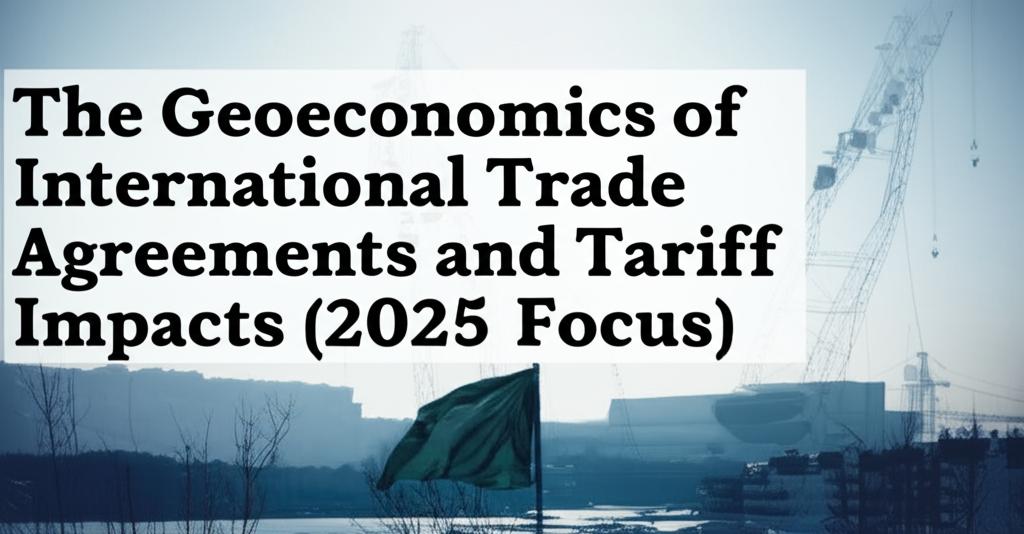The global economic landscape in 2025 is significantly shaped by the interplay of international trade agreements and the impact of tariffs. Geopolitical tensions, protectionist policies, and strategic economic competition are leading to a reordering of global trade.
Key Geoeconomic Trends and Tariff Impacts in 2025:- Increased Protectionism and Trade Disputes: 2025 is marked by a surge in protectionist measures, including new tariffs and trade barriers. Several sources highlight the United States' implementation of significant tariff increases, including a baseline 10% tariff on all trading partners and even higher rates for specific countries like China, Japan, and the EU. These actions, and retaliatory measures from other nations, are creating a more fragmented and uncertain global trading environment. For instance, China has retaliated with substantial tariffs on U.S. imports.
- Shifting Trade Alignments: Geopolitical considerations are increasingly influencing trade patterns. Countries are reconfiguring trade relationships, sometimes prioritizing geopolitical alignment over pure economic efficiency. This is evident in the United States shifting some trade away from China towards countries like Mexico and Vietnam, and European economies reducing trade with Russia while increasing it with partners like the U.S. However, some "middle power" nations, including India and Brazil, are expanding trade across the geopolitical spectrum.
- Impact on Global Growth Forecasts: The rise in tariffs and trade policy uncertainty is leading to downward revisions of global economic growth forecasts for 2025. Organizations like J.P. Morgan, the International Monetary Fund (IMF), and the World Trade Organization (WTO) have all lowered their projections for global GDP and trade volume growth. For example, J.P. Morgan revised its 2025 U.S. real GDP growth estimate down to 1.6% (and later to 1.3% after auto tariff announcements) and China's growth to 4.4%. The IMF reduced its global growth forecast for 2025 to 2.8% (reference forecast including recent tariff announcements) and global trade growth to 1.7%. Some analyses suggest that if a global trade war were to escalate, the negative impact on global GDP could be severe.
- Inflationary Pressures and Consumer Impact: Tariffs are expected to contribute to inflationary pressures in 2025. Higher import costs are likely to translate to increased consumer prices. J.P. Morgan forecasts U.S. PCE price inflation to climb to 2.7% and core PCE inflation to 3.1% in 2025 due to tariffs. One analysis estimates that the implemented tariffs in 2025 could lead to a 2.3% rise in the price level in the short-run, costing the average U.S. household around $3,800.
- Sector-Specific Impacts: Certain sectors are disproportionately affected by tariffs. The automotive, steel, aluminum, and manufacturing industries are frequently mentioned. Developing countries may face higher duties on agricultural exports and in sectors like textiles and apparel, limiting their market access and competitiveness. "Tariff escalation," where higher tariffs are applied to finished goods than raw materials, can also hinder industrialization in developing economies.
- Supply Chain Reconfiguration and Resilience: Businesses are being forced to re-evaluate and reconfigure their supply chains in response to geopolitical instability and trade restrictions. This may involve diversifying sourcing, exploring "connector economies" (emerging markets with advantageous trade agreements), and investing in technologies for better supply chain visibility. The focus is shifting from pure efficiency to risk mitigation and resilience.
- Role of "Connector Economies": Nations like Mexico, Vietnam, India, Brazil, and some Southeast Asian countries are emerging as "connector economies." They are playing a crucial role by acting as intermediaries in trade flows between major economic blocs or by benefiting from shifts in sourcing strategies.
- Increased Uncertainty: The overall environment is characterized by heightened uncertainty regarding future trade policies, which can dampen business investment and consumer sentiment. This uncertainty itself is a significant drag on economic activity.
- Governments are employing various strategies, including industrial policy and subsidies, to support domestic industries and achieve strategic competitiveness goals.
- There are calls for strengthening multilateral cooperation and reforming institutions like the WTO to address current challenges, including dispute resolution and tariff-setting rules.
- Some temporary suspensions of tariffs on certain products have been implemented by governments to alleviate costs for businesses.
In summary, 2025 is a pivotal year where geoeconomic forces are actively reshaping international trade. While tariffs aim to protect domestic industries and address trade imbalances, they also contribute to slower global growth, higher inflation, and increased economic uncertainty, forcing businesses and policymakers to adapt to a rapidly evolving global landscape.

